Review: Apple and Blackmagic's eGPU with Thunderbolt 3 connectivity
AppleInsider takes an in-depth look at Apple and Blackmagic's Thunderbolt-enabled eGPU, testing the MacBook-accelerating hardware with a gamut of tests from 5K gaming to video editing. We show you everything that sets this eGPU apart from the pack.
The Blackmagic eGPU, built in cooperation with Apple, might seem pricey at $699, but it comes packing a Radeon Pro 580 GPU, the same chip that comes in the top-spec 2017 5K iMac. By itself, the silicon is worth just under $300, and you can now get it bundled with some other eGPU's for around $500.
So why would anyone want to pay extra for this particular unit from Blackmagic and Apple?
For one, the Blackmagic is the first eGPU to support Thunderbolt 3 and USB-C monitors like LG's 4K and 5K UltraFine displays, meaning well-heeled MacBook Pro owners can turn their portable rig into something closer to a desktop.
If you don't have or don't plan on buying an LG UltraFine display, the Blackmagic also works with any USB-C or HDMI monitor. DisplayPort screens are also supported with the help of a separate adapter.
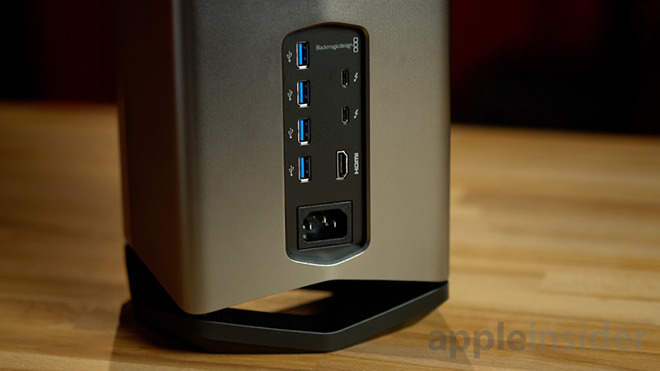
In addition to the two Thunderbolt 3 ports, the Blackmagic packs in four USB 3.1 ports and an HDMI 2 slot, besting a number of competing eGPU boxes. The extra inputs and outputs can be used to connect external storage drives, keyboards, mice, or simply charge an iPhone.
The Blackmagic works with any Thunderbolt 3-equipped Mac, and it provides 85 watts of charging for your MacBooks. For now, the setup is a macOS-only affair, as the eGPU does not yet support Windows 10.
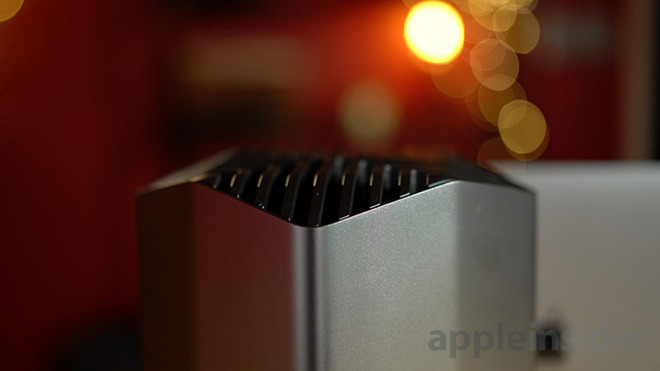
From a design standpoint, it's undoubtedly the best-looking eGPU we've ever seen, and it's built with high-quality materials.
This leads us to one of the biggest reasons why you would choose this eGPU over another model: incredibly quiet fan noise and low temperatures. It features a large fan that sucks air through the bottom and pushes it out of the top, just like the late 2013 Mac Pro.
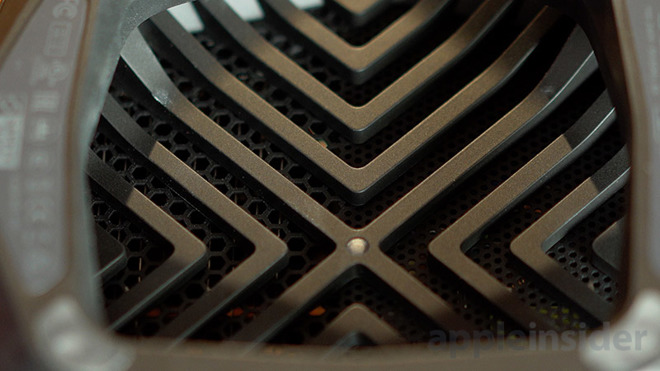
It's incredibly quiet, even at full load, a major upgrade from competing hardware that gets increasingly loud as operating temperatures heat up. In fact, the Blackmagic is so quiet that we forgot it was on while playing a demanding session of Fortnite at 5K resolutions.
We turned the settings down to around 1080p at medium graphics settings and saw frame rates rise to around 40 to 45fps, but we still experienced frame drops that made the game unplayable.
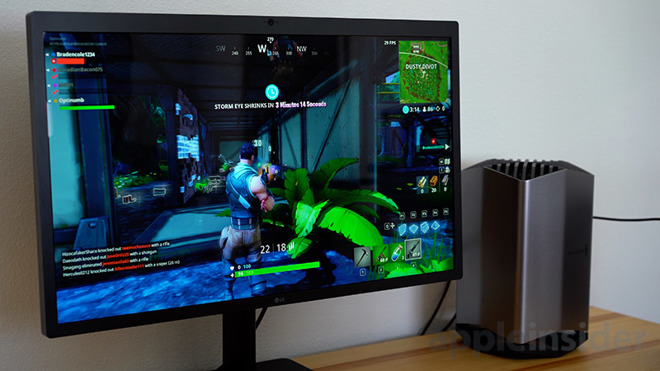
Connecting the Blackmagic eGPU and LG's 5K display, we set the game's resolution to 5K, or 5,120-by-2,880 pixels. Graphics quality (obviously) improved and frame rates were hovering at around 30fps. Unlike the MacBook Pro's integrated graphics chip, the eGPU was able to keep things much more consistent, with no frame drops that ruined gameplay.
Dropping graphics settings to medium boosted frame rates to about 40fps, and everything still looked great.
We also hooked it up to a regular 4K display using a Thunderbolt 3-to-DisplayPort cable and saw around the same 35fps at 4K "Epic" settings.
Throughout testing, both the Blackmagic eGPU and the MacBook Pro were whisper quiet.
Video editing, however, is a different story. In Final Cut Pro X, the Blackmagic eGPU allows the 13-inch MacBook Pro to export a five minute 4K h.264 clip with added effects in less than half the time of the integrated GPU. That puts the smaller MacBook Pro's performance nearly on par with the base 15-inch MacBook Pro. Interestingly, in some cases the 15-inch MacBook Pro gets slower when using the eGPU.
For example, when attached to the 13-inch MacBook Pro, the eGPU cut processing time in half for a one minute 4.5K Red RAW clip with added effects. However, the 15-inch MacBook Pro was almost twice as slow when combined with the eGPU.
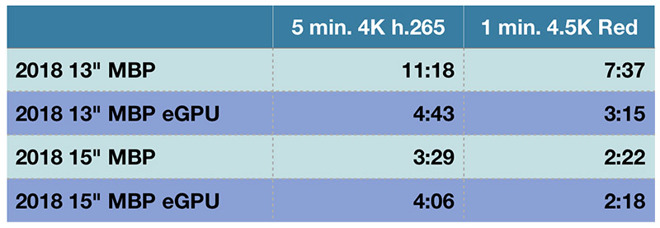
Stabilizing a 4K clip on the 13-inch with eGPU was basically just as fast as the base 15-inch MacBook Pro, both with and without the eGPU. To our surprise, the 13-inch MacBook Pro with the eGPU was faster in the Bruce X 5K benchmark, finishing almost three times faster than the 15-inch MacBook Pro's discrete GPU.
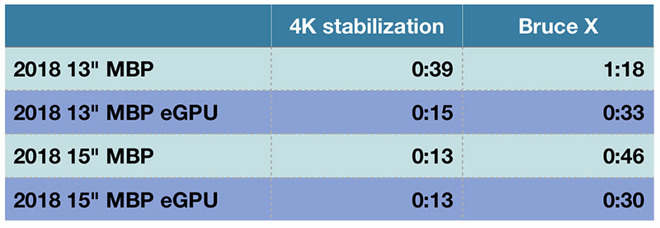
We tested 4K 60fps Canon Cinema RAW Lite footage in a one minute project with color corrections and a LUT applied on the 15-inch MacBook Pro, with and without the eGPU. We saw a vast improvement not only in export speeds, but timeline smoothness as well. We went from not being able to play back the footage in full resolution to smooth playback in 4K, in both 24fps and 30fps.

Geekbench 4's OpenCL test shows us the raw graphics performance of each GPU, and as you can see, it's a massive improvement over the 15-inch MacBook Pro's GPU.
We also ran the Unigine Heaven gaming benchmark and the 13-inch MacBook Pro with the Blackmagic eGPU greatly outperformed the 15-inch MacBook Pro. The 13-inch model fell behind by a couple of frames when compared to the 15-inch with the eGPU.

On the other hand, if you own an LG UltraFine display or a 2018 13-inch MacBook Pro, the solution is definitely appealing. With the 13-inch MacBook Pro, you get added portability when on the go and a quad-core, 8GB Radeon Pro 580 workstation in the home or office, nearing the performance levels of a 15-inch Macbook Pro with i9 CPU.
Overall, the Blackmagic eGPU is a specialty product that makes a lot of sense for a smaller group of people. It's more expensive than other solutions using the same GPU, and it's not upgradable. If you need Thunderbolt 3 support and would like a near silent experience, however, there's nothing else like it.
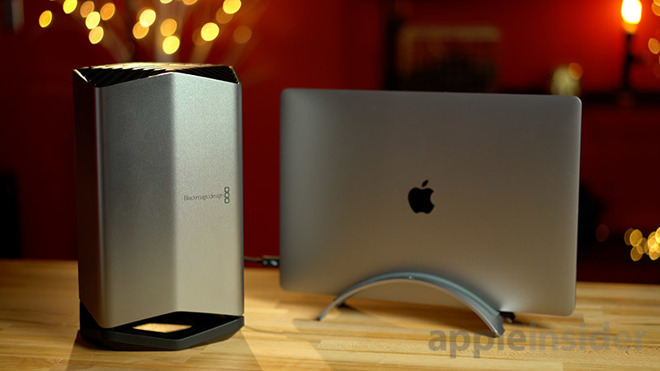
The Blackmagic eGPU, built in cooperation with Apple, might seem pricey at $699, but it comes packing a Radeon Pro 580 GPU, the same chip that comes in the top-spec 2017 5K iMac. By itself, the silicon is worth just under $300, and you can now get it bundled with some other eGPU's for around $500.
So why would anyone want to pay extra for this particular unit from Blackmagic and Apple?
For one, the Blackmagic is the first eGPU to support Thunderbolt 3 and USB-C monitors like LG's 4K and 5K UltraFine displays, meaning well-heeled MacBook Pro owners can turn their portable rig into something closer to a desktop.
If you don't have or don't plan on buying an LG UltraFine display, the Blackmagic also works with any USB-C or HDMI monitor. DisplayPort screens are also supported with the help of a separate adapter.

In addition to the two Thunderbolt 3 ports, the Blackmagic packs in four USB 3.1 ports and an HDMI 2 slot, besting a number of competing eGPU boxes. The extra inputs and outputs can be used to connect external storage drives, keyboards, mice, or simply charge an iPhone.
The Blackmagic works with any Thunderbolt 3-equipped Mac, and it provides 85 watts of charging for your MacBooks. For now, the setup is a macOS-only affair, as the eGPU does not yet support Windows 10.

From a design standpoint, it's undoubtedly the best-looking eGPU we've ever seen, and it's built with high-quality materials.
This leads us to one of the biggest reasons why you would choose this eGPU over another model: incredibly quiet fan noise and low temperatures. It features a large fan that sucks air through the bottom and pushes it out of the top, just like the late 2013 Mac Pro.

It's incredibly quiet, even at full load, a major upgrade from competing hardware that gets increasingly loud as operating temperatures heat up. In fact, the Blackmagic is so quiet that we forgot it was on while playing a demanding session of Fortnite at 5K resolutions.
Performance
The eGPU drastically improved the gaming performance of a base model 2018 13-inch MacBook Pro with Touch Bar. With the MacBook's internal Intel Iris Plus Graphics 655 running at maxed-out resolution and high video quality settings, we were able to achieve around 15 frames per second while playing Fortnite. Those speeds dropped down to 7fps at times and the laptop's fans were on full blast.We turned the settings down to around 1080p at medium graphics settings and saw frame rates rise to around 40 to 45fps, but we still experienced frame drops that made the game unplayable.

Connecting the Blackmagic eGPU and LG's 5K display, we set the game's resolution to 5K, or 5,120-by-2,880 pixels. Graphics quality (obviously) improved and frame rates were hovering at around 30fps. Unlike the MacBook Pro's integrated graphics chip, the eGPU was able to keep things much more consistent, with no frame drops that ruined gameplay.
Dropping graphics settings to medium boosted frame rates to about 40fps, and everything still looked great.
We also hooked it up to a regular 4K display using a Thunderbolt 3-to-DisplayPort cable and saw around the same 35fps at 4K "Epic" settings.
Throughout testing, both the Blackmagic eGPU and the MacBook Pro were whisper quiet.
Photo & Video Editing
If you're a photo editor, an eGPU won't really make a difference, since apps like Adobe Photoshop and Lightroom mostly rely on Mac's CPU for heavy lifting. We were hoping to see an improvement while editing 42MP RAW images in Lightroom, but the lag is still there despite some assistance from the eGPU.Video editing, however, is a different story. In Final Cut Pro X, the Blackmagic eGPU allows the 13-inch MacBook Pro to export a five minute 4K h.264 clip with added effects in less than half the time of the integrated GPU. That puts the smaller MacBook Pro's performance nearly on par with the base 15-inch MacBook Pro. Interestingly, in some cases the 15-inch MacBook Pro gets slower when using the eGPU.
For example, when attached to the 13-inch MacBook Pro, the eGPU cut processing time in half for a one minute 4.5K Red RAW clip with added effects. However, the 15-inch MacBook Pro was almost twice as slow when combined with the eGPU.

Stabilizing a 4K clip on the 13-inch with eGPU was basically just as fast as the base 15-inch MacBook Pro, both with and without the eGPU. To our surprise, the 13-inch MacBook Pro with the eGPU was faster in the Bruce X 5K benchmark, finishing almost three times faster than the 15-inch MacBook Pro's discrete GPU.

We tested 4K 60fps Canon Cinema RAW Lite footage in a one minute project with color corrections and a LUT applied on the 15-inch MacBook Pro, with and without the eGPU. We saw a vast improvement not only in export speeds, but timeline smoothness as well. We went from not being able to play back the footage in full resolution to smooth playback in 4K, in both 24fps and 30fps.

Benchmarks
We performed benchmarks by attaching the Blackmagic to a base model 2018 13-inch MacBook Pro and a top-of-the-line 2018 15-inch MacBook Pro with 2.9GHz i9 CPU, 4GB Radeon Pro 560X graphics, and 32GB of DDR4 memory.Geekbench 4's OpenCL test shows us the raw graphics performance of each GPU, and as you can see, it's a massive improvement over the 15-inch MacBook Pro's GPU.
We also ran the Unigine Heaven gaming benchmark and the 13-inch MacBook Pro with the Blackmagic eGPU greatly outperformed the 15-inch MacBook Pro. The 13-inch model fell behind by a couple of frames when compared to the 15-inch with the eGPU.

Conclusion
Our testing shows the Blackmagic eGPU is not really worth the extra money if you already own a 15-inch MacBook Pro, are not a video editor and intend to use the hardware without an external monitor.On the other hand, if you own an LG UltraFine display or a 2018 13-inch MacBook Pro, the solution is definitely appealing. With the 13-inch MacBook Pro, you get added portability when on the go and a quad-core, 8GB Radeon Pro 580 workstation in the home or office, nearing the performance levels of a 15-inch Macbook Pro with i9 CPU.
Overall, the Blackmagic eGPU is a specialty product that makes a lot of sense for a smaller group of people. It's more expensive than other solutions using the same GPU, and it's not upgradable. If you need Thunderbolt 3 support and would like a near silent experience, however, there's nothing else like it.



Comments
I have 2016 maxed out 13" MBP and an LG UltraFine 5K monitor. Adding the BlackMagic inline to the 5K been a game changer for my casual video editing and World of Warcraft sessions (neither is work, but therapy
Can't speak to the 2018 13" personally (this review does a great job of that), but if you have a 2016 13" or 2017 13" and an LG UltraFine 5K display, I highly recommend it! It's like having a real workstation at home, and ultra portability on the go...
I guess we'll see if this product gets updates going forward....if not, then I think its a poor purchase.
Two, three years down the road, these Blackmagic eGPU buyers will just buy a new eGPU box. Strange that they don’t offer a Vega version, but maybe being quiet was the number 1 priority and went with a lower performing, but cooler Polaris GPU, or whatever version it is using.
I do wonder that Apple is using macOS eGPU support as a testing and seeding ground for how the 2019 Mac Pro will work though. A 600 W 2 GPU box is coming for the Mac Pro?
Exactly... this is a done solution, out of the box, and is priced higher, accordingly. That's OK with the only real downside - for what it is - being how quickly it will become obsolete and rather worthless. And, yes, there are storage options, especially the fast SSD ones, that are pretty much what they are. Or, like you say, a lot of people who buy external hard drives don't open them and update the drive inside. That said, pros and GPUs are probably one of the biggest areas people would upgrade.
And, yes, it would be nice if it were kind of a best-in-class kind of card in there from the get-go. I'd imagine they would still be able to cool it similarly, though maybe a big bigger enclosure or something, or possibly slightly more noisy.
I'm guessing you're right on the Mac Pro (as others like Mike W have been indicating). It will probably be a core box with as many TB3 (or 4?) ports on it as possible and maybe a line of eGPUs, storage, and other add-ons. That might be OK now, whereas it really wasn't in 2013. I just hope for better OS support. It is silly they don't support more cards, and in Bootcamp, etc.... or even TB2.
Just because newer graphics cards will come out, doesn't mean this eGPU with the 580 chip will stop being able to get the job. You'll just have that feeling that it could be done faster if you upgrade.
1. Rather obviously, being quiet was a high priority for this particular collaboration, and the Blackmagic meets the goal of significantly improving your video card while not deafening you in the process. People who don't care about quiet don't care about Macs, I tend to find, so they'll buy a far noisier box that better meets their needs. I don't think future editions of this will significantly up the game either, because quiet is always going to be one of the top priorities. This is clearly designed as a "sweet spot" option in terms of noise, price, and performance. Going bigger/better/noisier would have cost a lot more.
2. 98 percent of even the maybe 10 percent of MBP buyers who actually need/want an eGPU at all will be perfectly happy with this, and it will continue to perform well for them for the entire life of their use of the 2018 MBP. This is why it comes with a great hub and works so well with monitors -- the number of people who are actually rendering the next Pixar-type movie in their spare room or doing something that absolutely requires the fastest/loudest/most-power-sucking card the universe presently has to offer and nothing less will do ... is a far, far smaller market than I think most tech-site readers would imagine it to be, particularly before we get into how much $$$ such a solution would cost you. That's the realm of the dedicated workstations, not a notebook.
Professionals, for whom time = money, are exactly those who will spend the money to put in the faster card when it comes out. Which again puts this in a bit of an different market than it seems to being pushed at (hence the questioning and pushback, IMO). What you guys are talking about is most the prosumer, or the professional user of such products who just needs enough power to work on the stuff, but isn't caring about a 8% or whatever performance gain.
I'm in this latter class, so this is kind of perfect (if I can wrap my mind around the pricing and laptop vs desktop solution aspect), but I'm not concerned if it takes 2.3 hours vs 2.6 hours to create the output (at least not at this point). The people I know working in 3D or After-effects like apps, though, would care quite a bit about that. If you're exporting a 20 minute video for YouTube, maybe you don't care about a 30 second time-savings... but if you're rendering a project that drops from 15 hours to 12 hours, you probably do. (Though, then, you're probably using an iMac Pro, not a MacBook Pro.)
And, that gets us back to the whole pro argument. Wouldn't that 98 percent you're talking about, Charles, also be just as happy with a TB3 MacBook Air with this eGPU? If most of Apple's pro market isn't pro anymore (in the traditional sense of the application of that term to product-lines), then of course pushing the boundaries of performance also isn't a huge concern, I guess.
Also, afaik, the GPU isn't constantly using the entire bandwidth of the connection. It might periodically do so when doing the most demanding things (graphics-wise). It would be interesting to know what percent of the bandwidth is being used under different circumstances (i.e.: just driving a 4k monitor, a 5k monitor, running a game, editing a video, etc.).
I'm having a hard time seeing myself wanting something much bigger and louder based on what everyone says about the other eGPU boxes out there. So, yeah, there's a market for this.
I'm more looking for something I'm not going to hear on the podcast/video I'm recording in a condenser mic. So, I suppose everyone has their level of what noisy is. I also can't stand those little fans in PC laptops. My wife has one she brings home from work and it's always spinning up and down and annoys the heck out of me. I like a really quite work-space, and if there is going to be noise, I'd rather have it be some music.
But, I agree, there is absolutely a place for this kind of thing. I'm a bit surprised it isn't bigger, in fact (the market, not the unit). Hopefully other units will take note and we'll get some competition in terms of the GPU used and good/better designs.